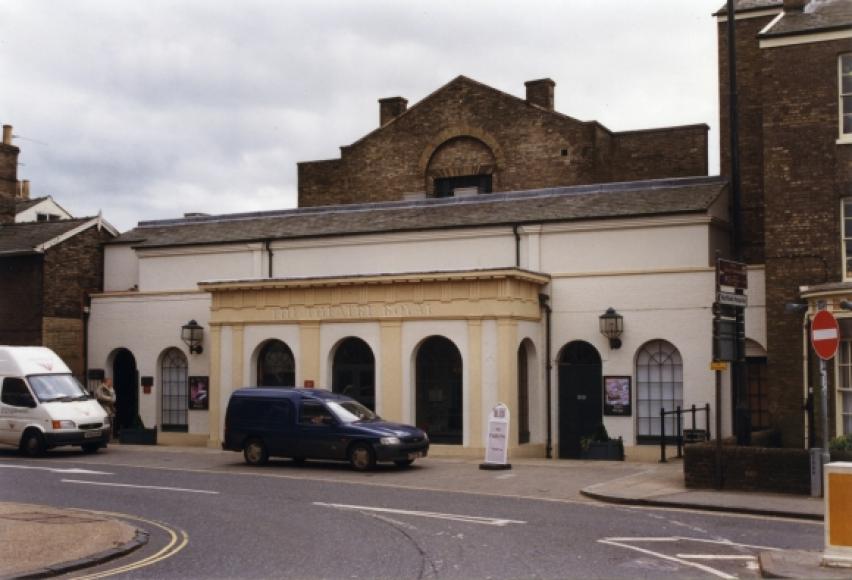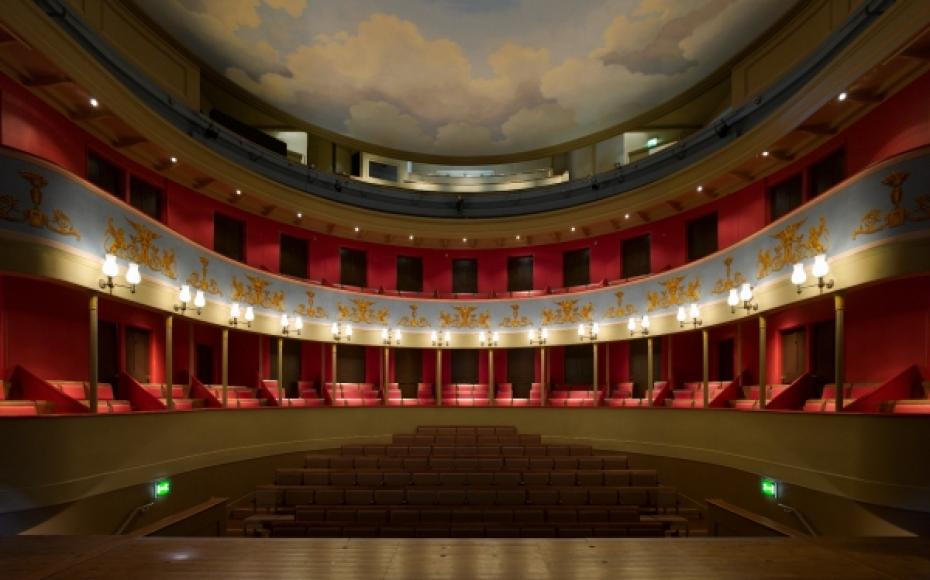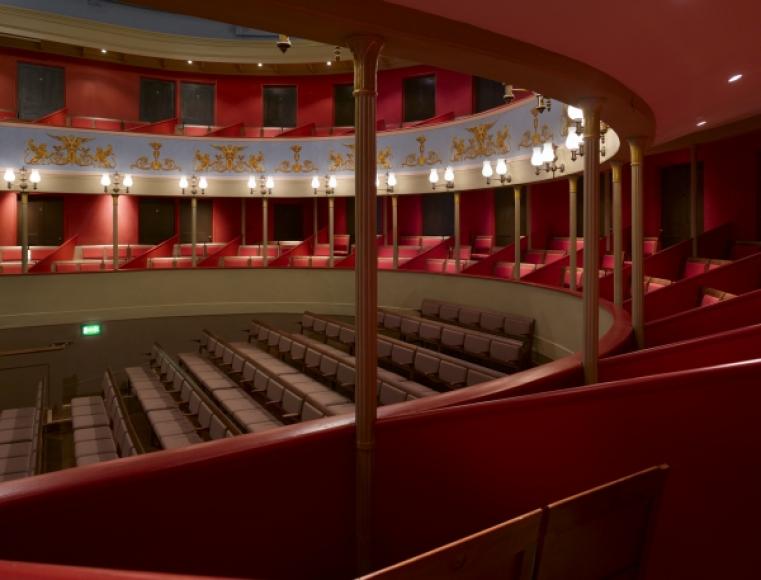Theatre Royal Bury St Edmunds
The Bury Theatre Royal is unusual in that it is one of the few existing nineteenth century theatres built by major but non-specialist architects - others being the Royal Opera House in Covent Garden, the Grand in Leeds, and the Theatre Royal Drury Lane.
The younger William Wilkins was, for all his distinction as leader of the Neo-Classical movement (his work includes Downing College, Cambridge and the National Gallery, London), a man of the theatre. He followed his father, also William Wilkins, as proprietor of the East Anglian circuit, which included the former Barnwell Theatre in Cambridge (see Cambridge Festival Theatre). They had rebuilt all their theatres before William the Younger decided to erect 'a theatre of ample dimensions and elegance' in Westgate Street, Bury St Edmunds.
Alterations were made in 1906 by Bertie Crewe, including movement of the forestage. In 1920 neighbouring brewery Greene King purchased the theatre. Facing competition from two new cinemas in the town, they closed the theatre in 1925 and it became a barrel store. In this use, the precious Georgian auditorium remained unaltered until the 1960s, when Air Vice Marshall Stanley Vincent and other local supporters raised £37,000 to restore and reopen the theatre. In 1975 the National Trust took on a 999-year lease for the building (the first theatre acquired by the Trust), and it was under their care that the theatre closed in 2005 for a major restoration programme, the aim of which was to restore the building to (a modern working version of) its 1819 state. The theatre re-opened in September 2007.
The auditorium is on four levels and originally held 800. The pit is surrounded by a double horseshoe of boxes. The upper tier, which is supported by sixteen slender cast iron pillars on the forward edge of the tier below, consists of an unbroken sweep of fifteen boxes with no pillars to obstruct the view. This is achieved by setting back of the gallery above a canopy, an effect that gives the whole a grace and an elegance which one might associate more with a European court theatre than an English country playhouse. The auditorium decoration comes in the form of trompe l'oeuil on the front of the balcony and the ceiling, hand painted by scenic artists Kit and Meg Surrey in 2007.
The proscenium is rectangular in shape, 7.3m (24ft) wide and 5.5m (18ft) high, and is flanked by pairs of marbled classical piers between which are curved and panelled proscenium arch doors. The line of the present forestage was greatly debated prior to the 2005 restoration, and is believed to now be returned to the 1819 height. The centre gangway in the stalls seating inserted in 1965 was removed during the 2005 restoration. At this time the stage boxes linking the lower tier to the outer proscenium pilasters were also reinstated. A 1906 improvement which pleases is the breaking open of the screen wall behind the upper tier of the boxes.
The exceptionally large stage, 12.2m (40ft) wide by 12.2m deep had been removed between 1925, when the theatre closed, and 1962 when it ceased to be a barrel store. The theatre was restored by a specially formed Trust which employed Ernest Scott as architect assisted by Iain Mackintosh as consultant. The modern stage surface is unfortunately flat where once it was raked. Although the walls and the main roof trusses are original, the scenic suspension system is modern and depends on a tubular structure introduced in 1965 to take the load down on to concrete pads in the basement below.
The theatre presents an attractive small scale classical facade to Westgate Street. The theatre foyer is, post-restoration, to the side of the building, on the site of an adjacent garden. Above the porte-cochere, now glazed, is the windowless circle bar, introduced in 1906 and extended in 1974 to include additional escape stairs from the gallery. The theatre is free standing save for an uneasy connection with the adjoining house, reputedly by Wilkins himself on land he sold off to pay for the theatre.
For a time the box office and staff offices were located in 6 Westgate Street next door, until 2015 when they were moved back in to the main theatre building.
As the sole surviving Regency theatre in the country, the theatre has taken on the role of rediscovering and presenting the forgotten repertoire of that era.
- 1819 - 1903: Theatre
- 1906 - 1925: Theatre
- 1925 - 1965: Barrel Store
- 1965 : Continuing - Theatre
Further details
- 1819 Design/Construction:William Wilkins the Younger- Architect
- 1819 Owner/Management: William Wilkins the Younger
- 1819 - 1903 Use: Theatre
- 1838 Alteration: Gas lighting introduced
- 1843 Owner/Management: William James Achilles Abington
- 1906 Alteration: Alterations, mainly to auditoriumBertie Crewe- Architect
- 1906 - 1925 Use: Theatre
- 1908 Owner/Management: Run by shareholders under a Directorate - G A Auguste and A Penleve
- 1912 Owner/Management: Theatre Royal Company Ltd - lessee Florence Glossop-Harris
- 1920 Owner/Management: Greene King & Sons (brewers), freeholders
- 1925 - 1965 Use: Barrel Store
- 1965 Use: Continuing - Theatre
- 1965 - 1966 Alteration: Partially restoredIain Mackintosh- Consultanttheatre consultantErnest Scott- Architect
- 1974 Alteration: Further improvementsNorman Westwater- Architect
- 1975 Owner/Management: National Trust 999 year lease from Greene King; Bury St Edmunds Theatre Management Ltd, sub-lessee
- 1994 Alteration: Single-storey extension at rearPurcell Miller Tritton- Architect
- 1995 Alteration: Facade improved; forecourt lowered to 1819 level; foyer and auditorium ceiling redecoratedPurcell Miller Tritton- Architect
- 2005 - 2007 Alteration: Major restorationLevitt Bernstein (Axel Burrough And Rachel James)- ArchitectDavid Wilmore- Theatre
- CapacityOriginalDescription800
- CapacityLaterDescription1977: 352
- CapacityCurrentDescription352
- ListingI



